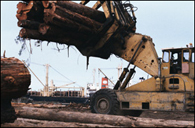|
Physical Properties
The principal physical properties of wood are strength, hardness, stiffness,
and density. Density is generally an indication of the mechanical properties, inasmuch as dense woods
are usually hard and strong. The term strength covers a number of essentially different properties;
a wood that is high in one kind of strength is not necessarily high in others. Moreover, the strength
varies greatly with the state of seasoning, or dryness, of the wood, and with the direction of the
grain; wood is always much stronger when cut along the grain rather than across it, and for this reason
planks and such articles as poles and handles are always cut with the grain running the long way. Wood
has high compression strength, in some cases higher in proportion to its weight than steel; it has low
tensile strength and moderate shear strength.
High compression strength is required for foundations, and for the main supports
of buildings. Bending strength is essential for most structural wooden members, including joists,
studding, and beams of all sorts. Many woods that are commonly used for high bending strength have high
compression strength, and vice versa; but oak, for example, is very strong in bending and comparatively
weak in compression, whereas redwood is strong in compression and comparatively weak in bending.
Hickory and ash have outstanding strength against sudden and repeated stress,
and are used in cartwheel spokes, baseball bats, and axe handles; because hickory is stiffer than ash,
it is preferred for thin handles, such as those of golf clubs. Other less important mechanical properties
may be critical for a particular use; for example, the elasticity and resonance of spruce render it the
only material suitable for the sounding board of a fine piano.
|



